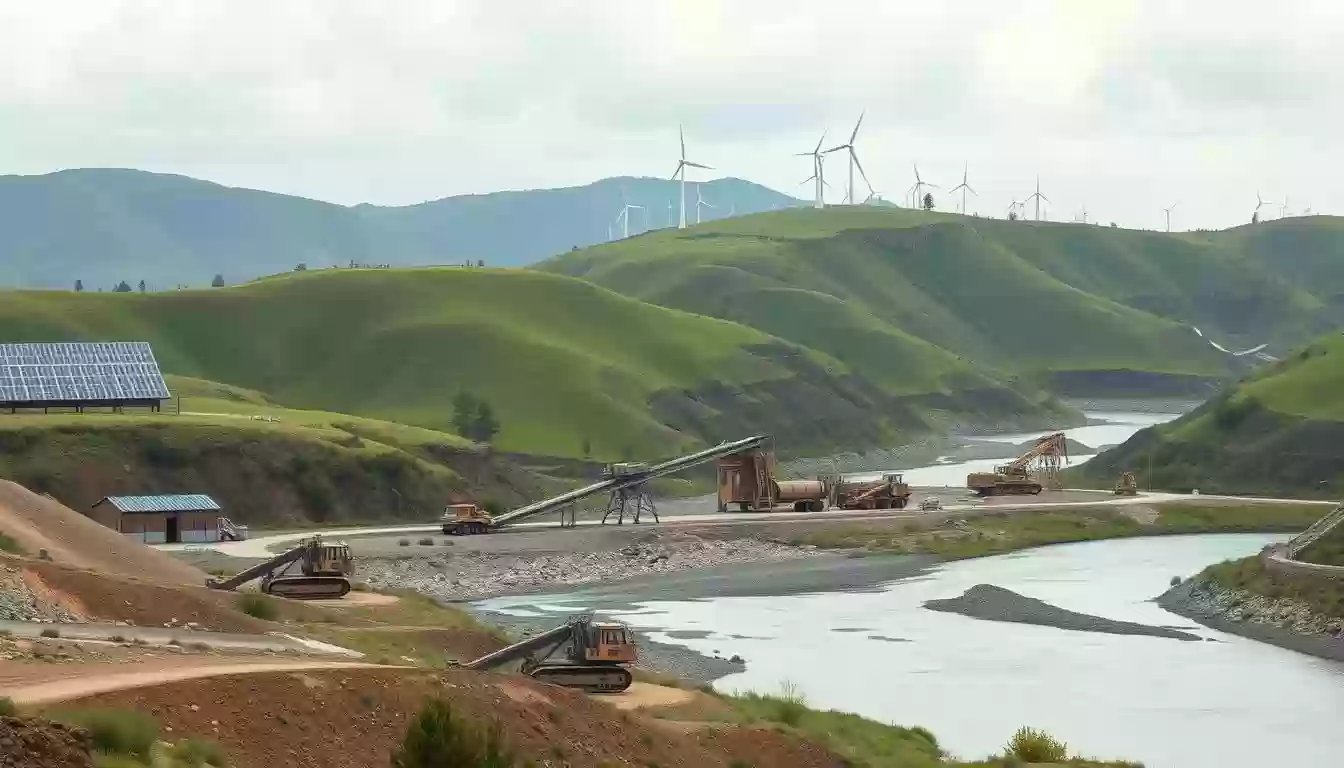Sustainable Mining Practices: A Comprehensive Guide
 08 Mar 25
08 Mar 25
As the world demands more metals and minerals, the mining industry faces a critical challenge: balancing resource extraction with environmental and social responsibility. Traditional mining practices have often led to significant environmental impacts, prompting a shift toward more eco-friendly approaches. This guide explores the emerging trends and strategies in sustainable mining, offering insights into how the industry can evolve to meet future demands responsibly.
The transition to sustainable mining is not just about reducing environmental harm; it's also about ensuring the long-term viability of the industry. Companies like Molycorp have set examples by implementing advanced land reclamation and water management systems. These efforts highlight the potential for mining practices that prioritize both resource production and environmental stewardship.
By adopting innovative technologies and innovative mining practices, the industry can minimize its ecological footprint while maintaining operational efficiency. This guide will delve into these strategies, providing a roadmap for companies aiming to align their operations with global sustainability goals. The future of mining is not just about extracting resources, it's about doing so in a way that benefits both people and the planet.
Introduction: The Need for Sustainable Approaches in Mining
As global demand for critical minerals like lithium and cobalt surges, the mining industry faces a pivotal moment. Traditional mining methods, while effective, often come at a significant environmental cost, making them increasingly unsustainable in today’s eco-conscious world.
Rising environmental and social concerns have created an urgent need for change. Regulatory shifts and community pressures are driving the industry towards more responsible practices. For instance, governments worldwide are implementing stricter policies to curb environmental impacts, while local communities are demanding greater accountability.
Sustainable mining is not just about reducing harm; it’s about finding a balance. It combines operational efficiency with environmental protection, ensuring that resource extraction doesn’t come at the expense of ecosystems or future generations. Innovative solutions and forward-thinking policies are key to this transformation.
Water usage is a critical area of focus. Optimizing processes to reduce consumption and minimize waste is essential. By improving efficiency and implementing systematic changes, the mining industry can pave the way for a more sustainable future.
Clear policies and community engagement are vital. Companies must adopt techniques that not only enhance efficiency but also align with global sustainability goals. The journey towards sustainable mining requires collaboration, innovation, and a commitment to responsible practices.
Environmental Impacts of Conventional Mining Methods
Conventional mining methods have severe environmental consequences that affect ecosystems and communities worldwide. The extraction process often leads to significant air and water pollution, primarily due to the release of harmful chemicals and heavy metals.
Air and Water Pollution Challenges
One of the most immediate effects of traditional mining is the contamination of air and water. For instance, the use of chemicals like cyanide in gold extraction can leak into nearby water sources, posing risks to both aquatic life and human health. Similarly, dust and pollutants from mining operations can degrade air quality, leading to respiratory issues in nearby communities.
| Environmental Impact | Traditional Mining Methods | Eco-Friendly Alternatives |
|---|---|---|
| Air Pollution | High levels of dust and chemicals | Lower emissions with green technologies |
| Water Pollution | Chemical leakage into water sources | Cyanide-free extraction methods |
| Waste Generation | High waste production | Recycling and efficient waste management |
Long-Term Ecological Consequences
Beyond immediate pollution, conventional mining leads to long-term ecological damage. Soil degradation and the disruption of natural habitats are common issues. For example, improper tailings management can result in the contamination of soil, making it unsuitable for agriculture or wildlife. Additionally, illegal mining practices exacerbate these problems, often bypassing environmental regulations and causing irreversible damage to ecosystems.
Addressing these challenges requires a shift toward more responsible mining techniques and stricter enforcement of environmental standards. By adopting innovative solutions and improving waste management, the industry can reduce its ecological footprint and promote sustainable development.
sustainable mining practices for Eco-Friendly Operations
Modern mining is embracing eco-friendly practices to minimize environmental impact while maximizing efficiency. A key shift is the adoption of renewable energy sources and green equipment, which are transforming how mines operate.
Adopting Renewable Energy and Green Equipment
Renewable energy, such as solar and wind power, is becoming integral to mining operations. Companies are investing in electric-powered trucks and loaders, which reduce carbon emissions and lower fuel costs. For instance, electric vehicles in underground mines improve air quality and reduce ventilation needs, creating a safer environment for workers.
Waste Recycling and Water Management Techniques
Advanced recycling systems are turning waste into valuable resources, minimizing environmental harm. Water management strategies focus on recycling and conservation, with some companies reducing water usage by up to 40%. These practices not only protect resources but also enhance community safety by lowering operational risks.

By integrating these technologies, mining companies are achieving significant efficiency gains and reducing their ecological footprint. These innovations pave the way for a more sustainable future, balancing resource production with environmental stewardship.
Rehabilitating and Restoring Mining Sites
Rehabilitating abandoned and contaminated mining sites is crucial for environmental recovery and community safety. These areas often suffer from soil degradation and reduced biodiversity, making restoration a priority for both the industry and local communities.
Land Reclamation Methodologies
Effective land reclamation involves a combination of soil replenishment and vegetation restoration. Techniques such as applying biosolids to rebuild topsoil and using waste rock to fill excavated areas can significantly accelerate ecological recovery.
The use of biosolids and waste rock offers both economic and environmental benefits. These methods not only restore productivity to degraded lands but also reduce the need for new material extraction, lowering the industry's overall environmental impact.
Successful examples include initiatives by industry leaders that have transformed former mining areas into thriving ecosystems. These projects highlight the importance of proper planning and community involvement in ensuring long-term success.
Managing waste and tailings remains a challenge, but innovative solutions are emerging. By adopting systematic approaches, the industry can mitigate risks and promote sustainable development.
Ultimately, effective restoration can turn a degraded area into a productive ecosystem, benefiting both the environment and future generations.
Addressing Illegal Mining and Enhancing Community Safety
Illegal mining poses significant threats to both the environment and local communities, necessitating immediate action to enforce legal frameworks and protect resources. This dangerous practice often leads to severe environmental degradation and safety hazards, making it a critical issue for the mining industry.
Reducing Risks Through Legal Enforcement
One of the most pressing challenges in addressing illegal mining is the lack of effective legal enforcement. Without proper oversight, illegal operations can flourish, leading to devastating consequences for both ecosystems and nearby residents. For instance, in Plateau State, Nigeria, illegal mining has been linked to increased criminal activities and environmental degradation, highlighting the urgent need for stricter policies.
Stricter regulations and increased policing are essential to curbing illegal mining activities. Governments must implement and enforce laws that hold perpetrators accountable while also addressing the root causes, such as unemployment and economic desperation, that drive individuals to engage in illegal mining. Community engagement and education are also vital components of any successful strategy to combat illegal mining.

Examples from around the world demonstrate the effectiveness of coordinated efforts to combat illegal mining. In South Africa, for example, authorities have rescued hundreds of illegal miners trapped in dangerous conditions, underscoring the human cost of this practice. Similarly, in Plateau State, the government has implemented executive orders to prohibit mining activities and deployed significant resources to enforce these bans.
Protecting water resources is another critical aspect of addressing illegal mining. The use of hazardous chemicals in these operations often contaminates nearby water supplies, posing serious health risks to local communities. Ensuring efficient operations and protecting these resources are essential for both environmental and community safety.
Ultimately, a coordinated plan that combines legal enforcement, community engagement, and economic opportunities is necessary to address illegal mining effectively. By working together, governments, mining companies, and local communities can create a safer and more sustainable future for all.
Innovations and Technologies Driving Green Mining Solutions
The mining industry is undergoing a transformation driven by cutting-edge technologies that prioritize environmental stewardship. These innovations are reshaping how companies operate, making mining more efficient and eco-friendly.
Emerging Green Mining Technologies
One of the most promising advancements is the use of advanced reagents, which improve metal recovery while reducing the need for harsh chemicals. For instance, Syensqo’s reagents have enabled a 30% increase in copper recovery, setting a new standard for efficiency. Digital tools are also playing a crucial role, allowing for real-time data analysis that optimizes mining processes and reduces waste.
Renewable energy integration is another game-changer. Mining companies are increasingly adopting solar and wind power to reduce their carbon footprint. This shift not only lowers emissions but also cuts operational costs, making green mining more economically viable.
Case Studies and Successful Implementations
Molycorp’s revamped tailings storage system is a prime example of innovation in action. By implementing advanced recycling and containment methods, they’ve significantly reduced environmental risks. Similarly, China’s regulatory reforms on rare earth mining have led to cleaner practices, demonstrating how policy can drive positive change.
These examples highlight how technology and policy can work together to create a more sustainable future for mining. As the industry continues to evolve, such innovations will set new benchmarks for environmental responsibility and efficiency.
Building Sustainable Communities Around Mining Operations
Building sustainable communities around mining operations requires a holistic approach that goes beyond resource extraction. Mining companies play a pivotal role in fostering local economic growth and ensuring that environmental initiatives benefit the broader community. This section explores strategies for economic diversification and community development that create lasting, positive impacts.
Strategies for Economic Diversification
A key strategy for building sustainable communities is diversifying local economies. Mining companies can achieve this by transitioning to community-based enterprises and diversifying supply chains. For example, De Beers' 50-50 ownership structure with Debswana in Botswana ensures that mining profits are redistributed to the government and citizens, promoting economic growth and social development. This approach not only reduces reliance on mining but also creates a more resilient local economy.
Eco-friendly practices and waste reduction are equally important. By implementing advanced recycling systems and water management techniques, mining companies can minimize their environmental impact. For instance, reducing water usage by up to 40% through efficient processes not only protects resources but also enhances community safety by lowering operational risks. These practices create a healthier environment for both current and future generations.
Responsible management of mining tailings and by-products is another critical aspect. Proper containment and recycling methods can transform waste into valuable resources, reducing the industry's ecological footprint. Collaborative systems and strategic planning are essential for building resilient local economies. By working together, governments, mining companies, and local communities can create a safer and more sustainable future.
For example, communities like those in South Africa have successfully diversified their economies by integrating environmentally friendly operations into their planning. These initiatives not only protect the environment but also create new economic opportunities, ensuring that the benefits of mining extend beyond the life of the mine.
Ultimately, the goal is to ensure that mining operations contribute to the well-being of the entire community. By adopting these strategies, mining companies can help build thriving, sustainable communities that flourish long after the mine has closed.
Learn moreabout how sustainable mining practices can benefit local communities.
Conclusion
As we look to the future, it's clear that the mining industry must continue to evolve towards eco-friendly solutions. Embracing innovative technologies and systematic approaches is essential for reducing environmental impact while maintaining efficiency. Companies are now using advanced methods like remote sensing and AI to optimize mineral exploration, cutting costs by up to 30% and improving efficiency by 40%.
Rehabilitating mining sites and diversifying local economies are key to long-term sustainability. For instance, proper tailings management and water recycling have reduced environmental risks and improved community safety. These practices not only protect natural resources but also create economic opportunities, ensuring that the benefits of mining extend beyond the mine's lifespan.
The industry's shift towards greener techniques is driven by both innovation and policy. Stricter regulations and international standards, like the Extractive Industries Transparency Initiative, are pushing companies to adopt cleaner methods. This commitment to responsible practices ensures that mining contributes positively to both the environment and local communities.
Looking ahead, the focus must remain on continuous improvement and technological adoption. By prioritizing sustainable development and community engagement, the mining industry can ensure a brighter, more responsible future. It’s time for industry leaders to adopt best practices and for policymakers to support these efforts with robust regulations.
FAQ
What are the main environmental concerns in mining operations?
The primary environmental concerns include water pollution, waste management, and the ecological impact of tailings. Modern techniques aim to reduce these effects through efficient systems and recycling methods.
How does the mining industry address water management challenges?
The industry employs advanced water recycling and treatment systems to minimize water use and prevent contamination, ensuring environmentally friendly practices.
What steps are taken to rehabilitate mining sites after operations cease?
Land reclamation methodologies are used to restore ecosystems, including replanting and soil remediation, to return the area to a natural state or suitable land use.
How can illegal mining activities be mitigated?
Legal enforcement, community engagement, and policy development are key strategies to reduce illegal mining risks and ensure safe, regulated operations.
What role does technology play in advancing eco-friendly mining?
Emerging technologies focus on improving efficiency, reducing waste, and promoting sustainable resource use, driving the industry toward greener solutions.
How does the mining sector contribute to community development?
By implementing economic diversification strategies, the sector supports local communities, fostering growth and sustainability beyond mining operations.
What is the future outlook for sustainable mining practices?
The future holds promise with innovations in green technologies and responsible resource management, ensuring the industry's long-term viability and environmental stewardship.









